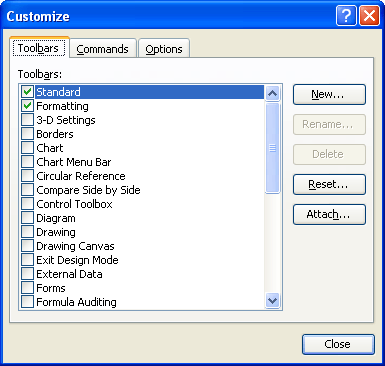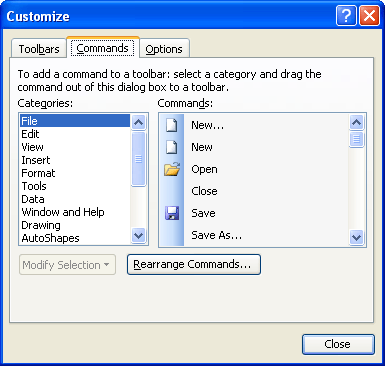Written by Allen Wyatt (last updated July 2, 2022)
This tip applies to Excel 97, 2000, 2002, and 2003
You can completely change Excel to reflect how you want to do your work. One of the elements of the program you can change is the toolbars. You can add, remove, or edit buttons that appear on any toolbar. To customize a toolbar, follow these steps:

Figure 1. The Toolbars tab of the Customize dialog box.

Figure 2. The Commands tab of the Customize dialog box.
ExcelTips is your source for cost-effective Microsoft Excel training. This tip (2724) applies to Microsoft Excel 97, 2000, 2002, and 2003.

Best-Selling VBA Tutorial for Beginners Take your Excel knowledge to the next level. With a little background in VBA programming, you can go well beyond basic spreadsheets and functions. Use macros to reduce errors, save time, and integrate with other Microsoft applications. Fully updated for the latest version of Office 365. Check out Microsoft 365 Excel VBA Programming For Dummies today!
Create your own toolbars and, at some point, you may have a hankering to change their names. Here's how you can make the ...
Discover MoreExcel normally displays the font list on the toolbar or using the very fonts it is displaying. Here's how to change that ...
Discover MoreAfter a time you may not need one of the custom toolbars you've created. This tip explains how to free up resources in ...
Discover MoreFREE SERVICE: Get tips like this every week in ExcelTips, a free productivity newsletter. Enter your address and click "Subscribe."
There are currently no comments for this tip. (Be the first to leave your comment—just use the simple form above!)
Got a version of Excel that uses the menu interface (Excel 97, Excel 2000, Excel 2002, or Excel 2003)? This site is for you! If you use a later version of Excel, visit our ExcelTips site focusing on the ribbon interface.
FREE SERVICE: Get tips like this every week in ExcelTips, a free productivity newsletter. Enter your address and click "Subscribe."
Copyright © 2025 Sharon Parq Associates, Inc.
Comments